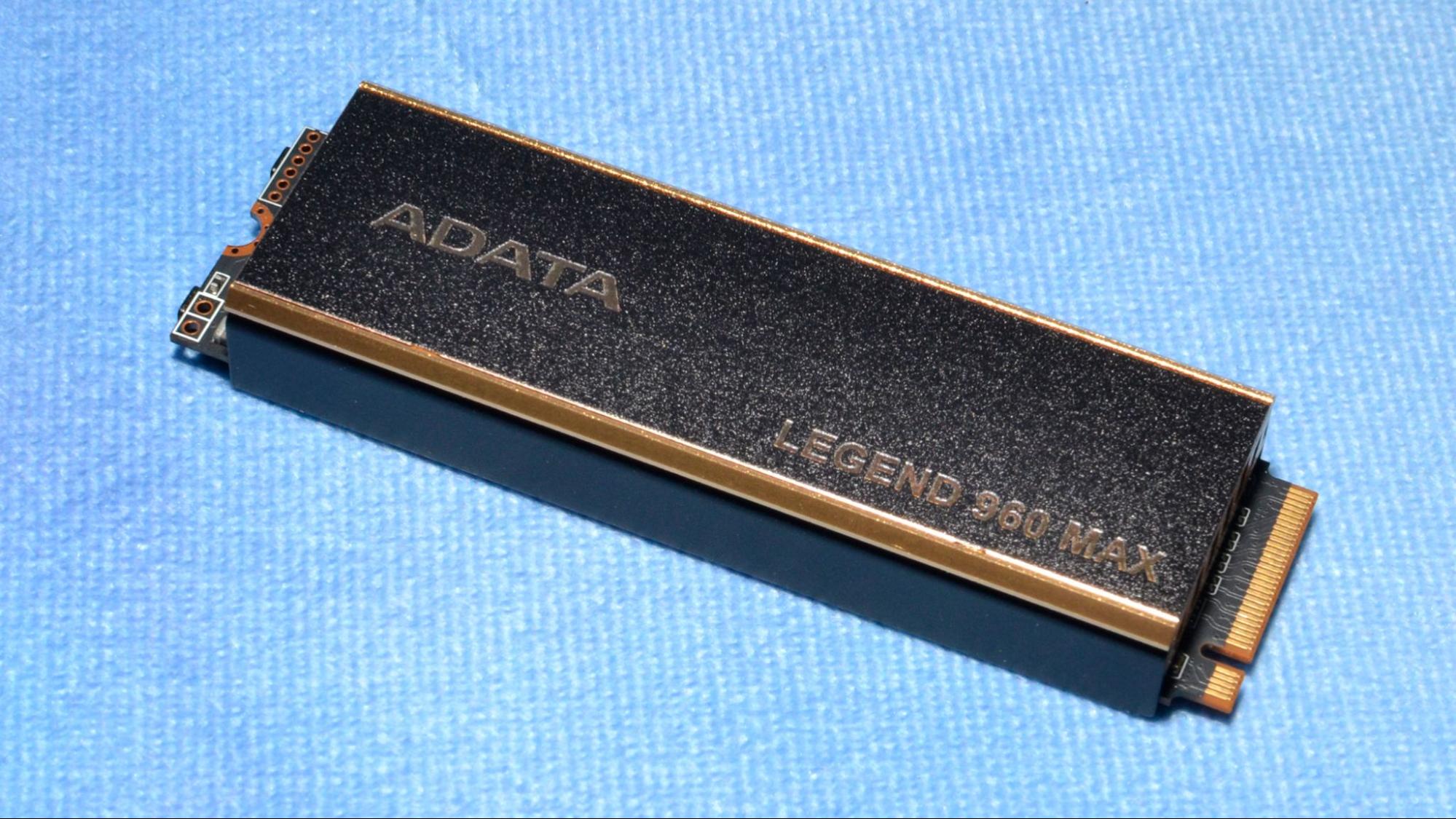Why you can trust Tom's Hardware
Comparison Products
The 2TB Adata Legend 960 Max is up against some of the best drives we’ve tested. Our comparison list includes the Samsung 990 Pro, the Solidigm P44 Pro, the Sabrent Rocket 4 Plus-G, the Adata Legend 960, the Acer Predator GM7000, the Corsair MP600 Pro LPX, the Sabrent Rocket 4.0, and the Gigabyte Aorus 7000s. The Rocket 4.0 is the odd one out here, being from the original crop of PCIe 4.0 SSDs designed for the X570 launch. The Aorus 7000s is using a fully-fledged 4.0 controller but was from the time of older Micron flash.
Trace Testing - 3DMark Storage Benchmark
Built for gamers, 3DMark’s Storage Benchmark focuses on real-world gaming performance. Each round in this benchmark stresses storage based on gaming activities including loading games, saving progress, installing game files, and recording gameplay video streams.
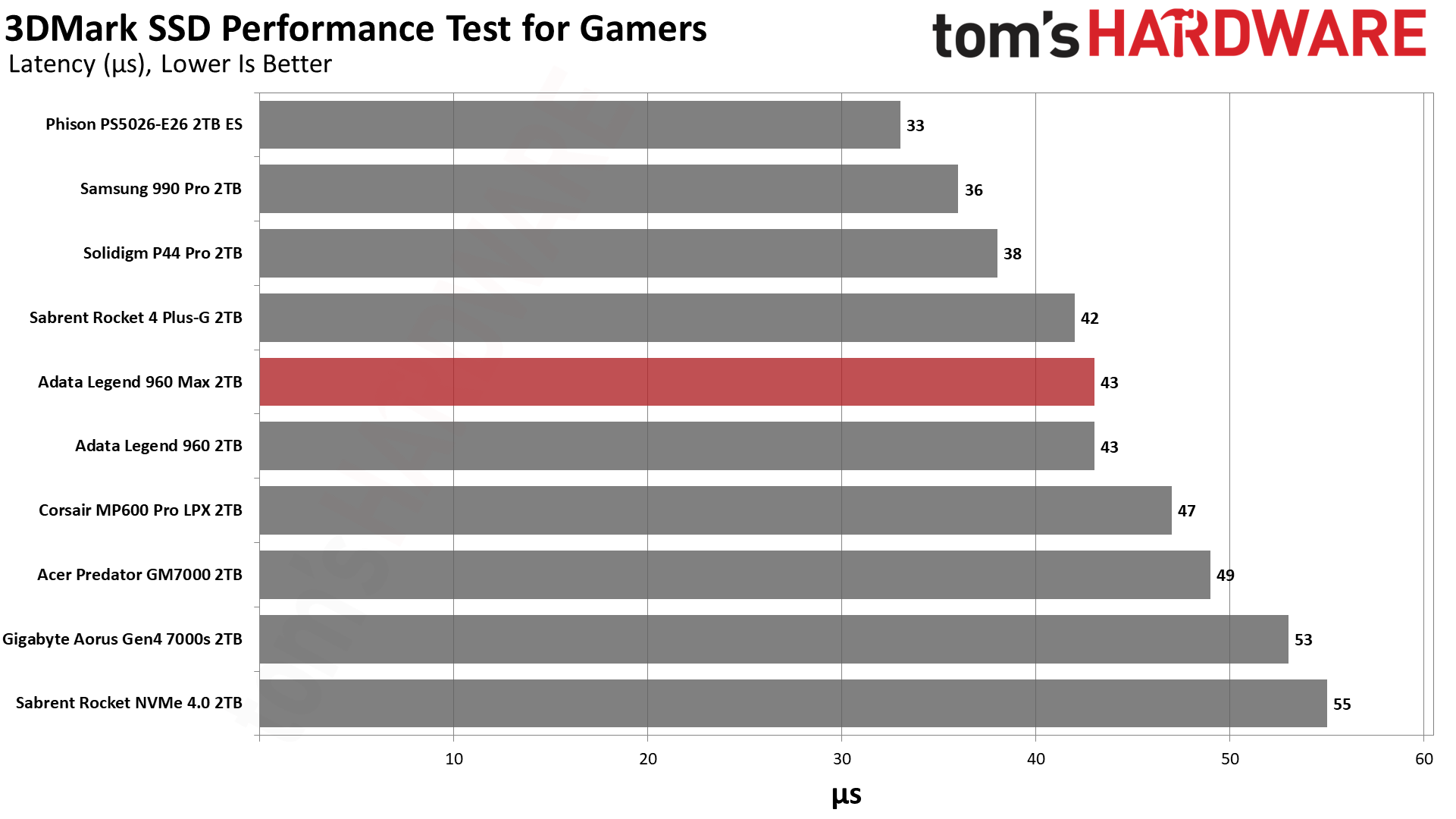
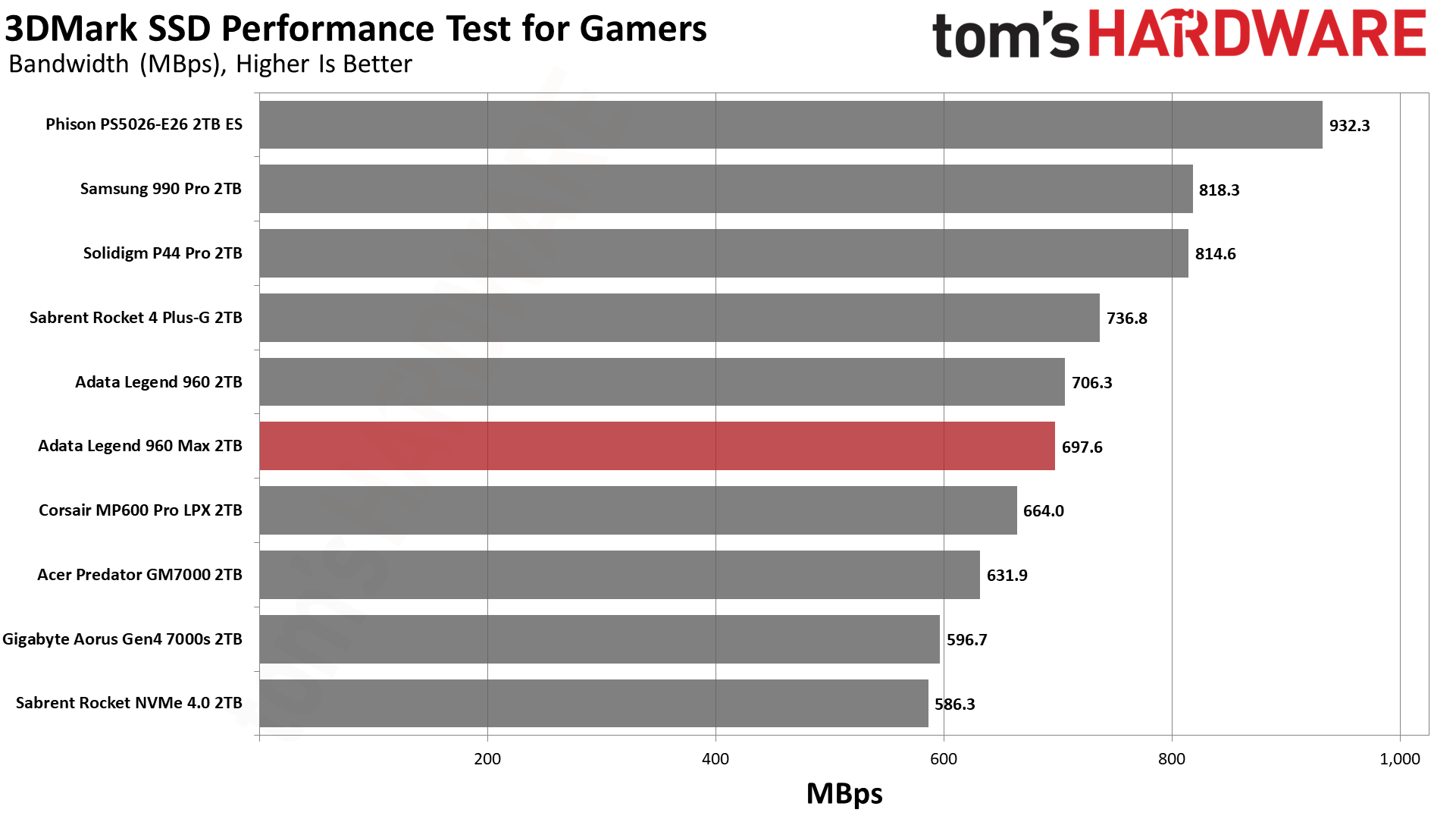
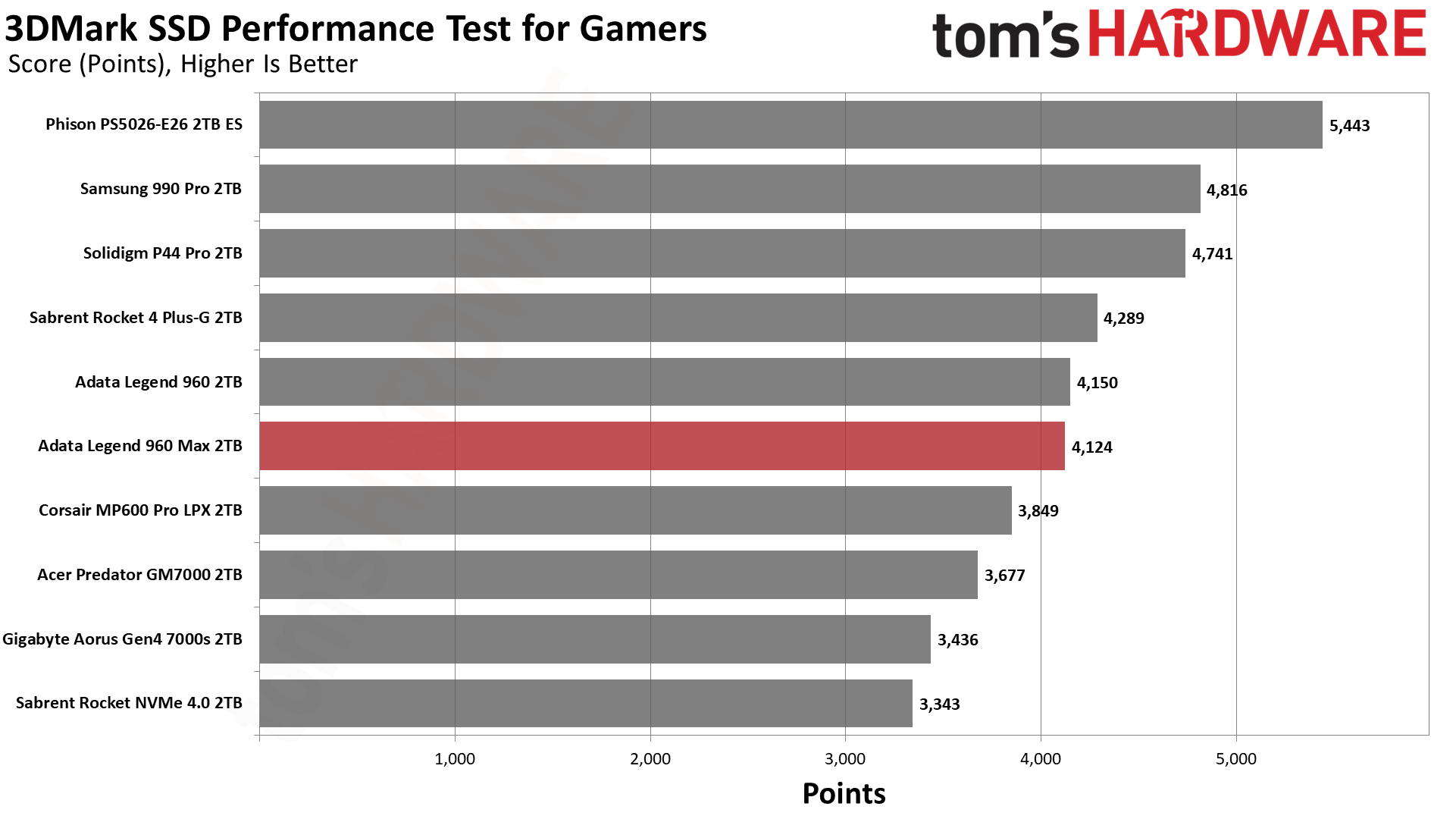
The Legend 960 Max is average in 3DMark and, as anticipated, the same as the original 960. This is “good enough” performance but suggests this drive must be cheaper than better offerings like the P44 Pro.
Trace Testing – PCMark 10 Storage Benchmark
PCMark 10 is a trace-based benchmark that uses a wide-ranging set of real-world traces from popular applications and everyday tasks to measure the performance of storage devices.
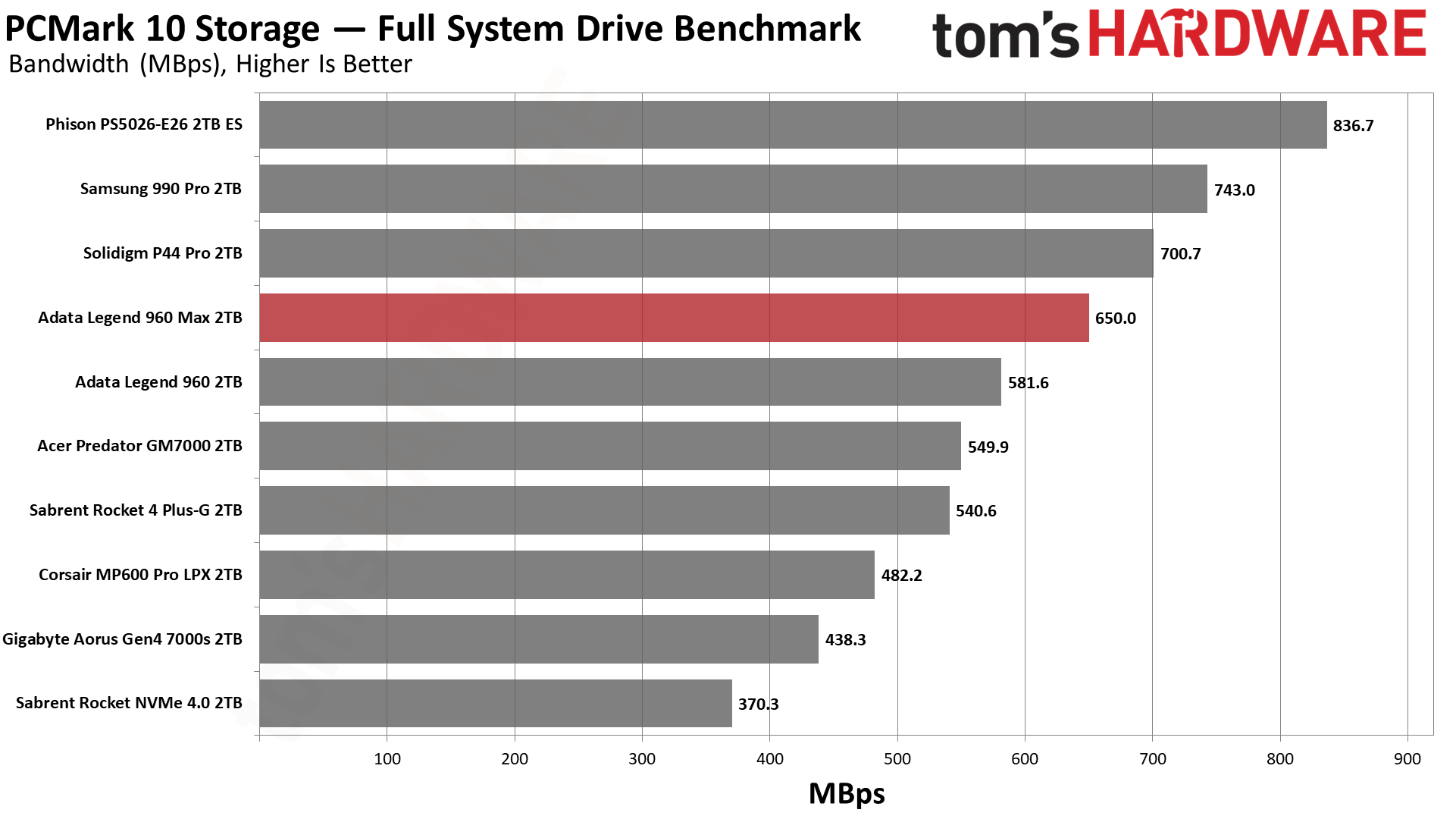
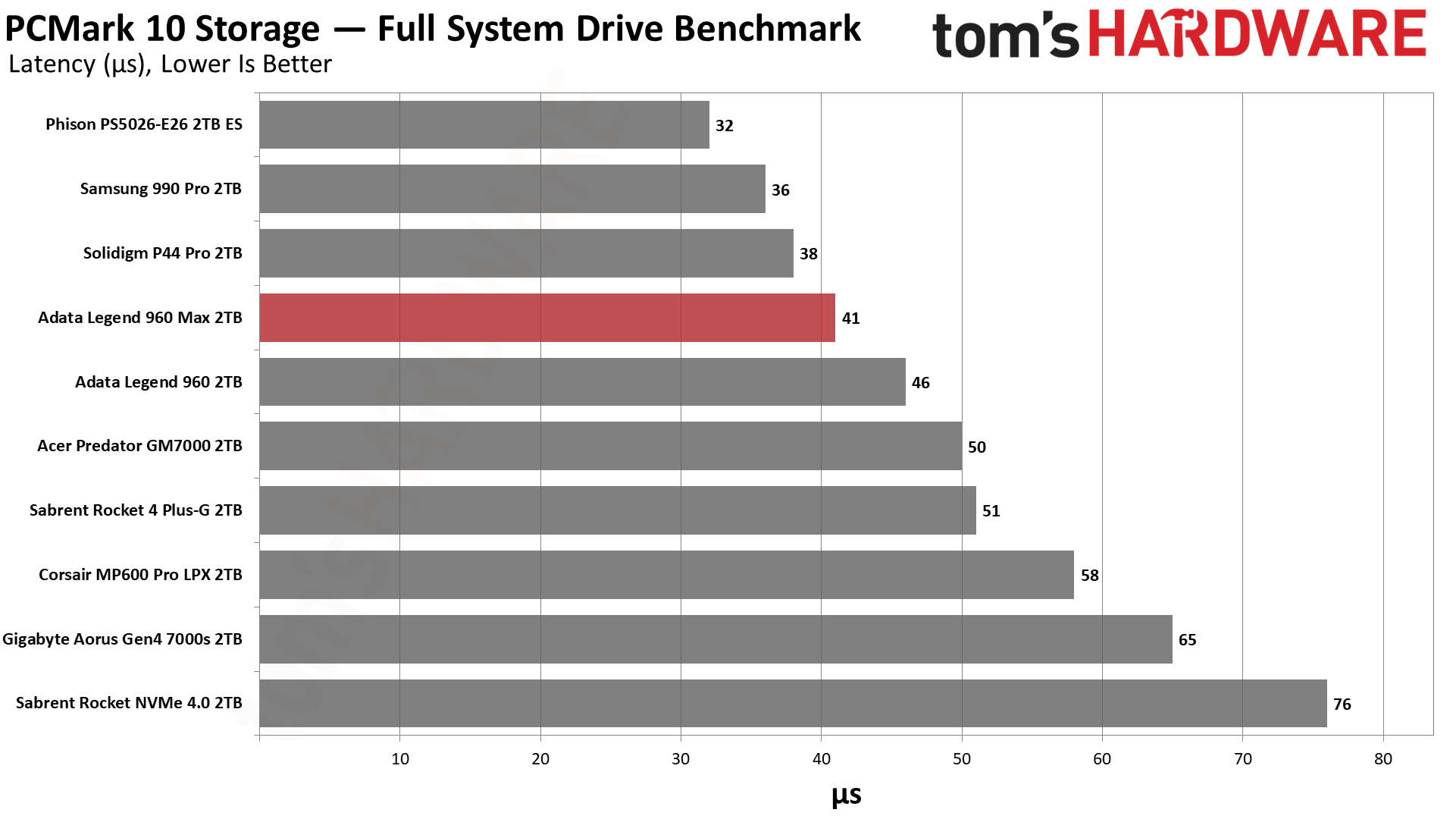
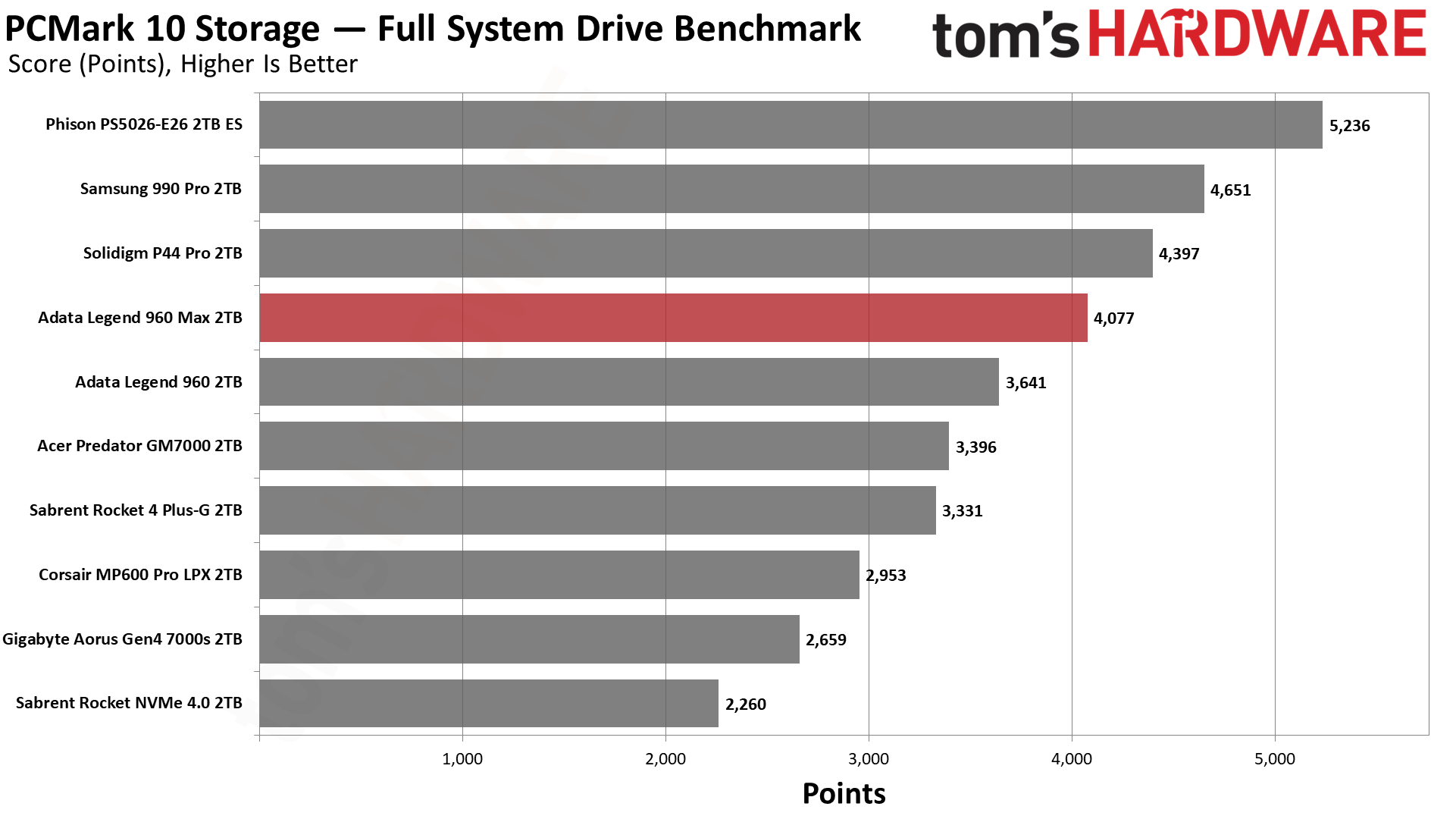
The Legend 96 Max does pretty well in PCMark 10, average to above average, but still can’t catch the P44 Pro or 990 Pro. SMI controllers and Micron’s flash have provided a good general user experience in the past, so this is plenty fast for daily use.
Transfer Rates – DiskBench
We use the DiskBench storage benchmarking tool to test file transfer performance with a custom, 50GB dataset. We copy 31,227 files of various types, such as pictures, PDFs, and videos to a new folder and then follow-up with a reading test of a newly-written 6.5GB zip file.
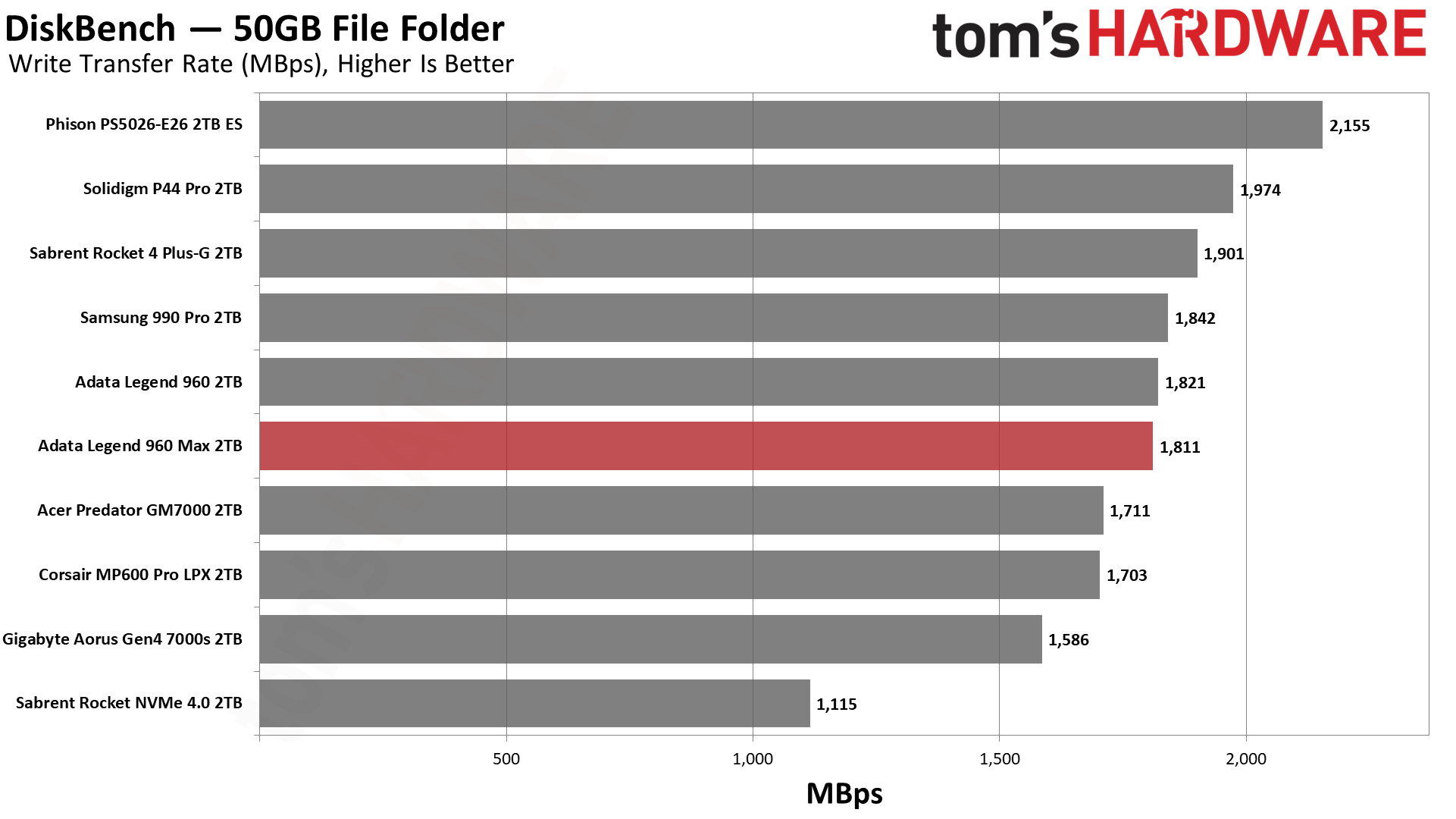
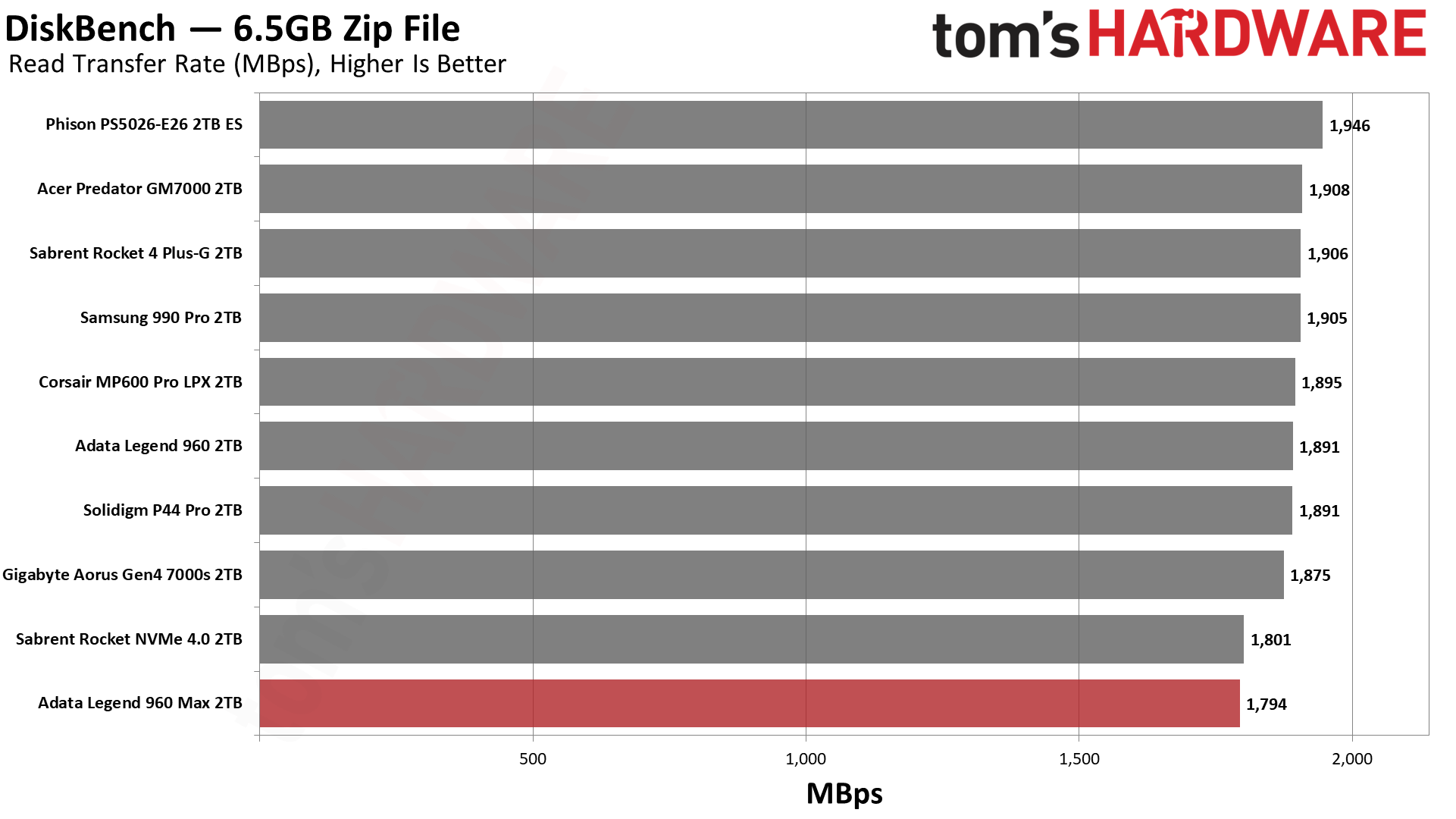
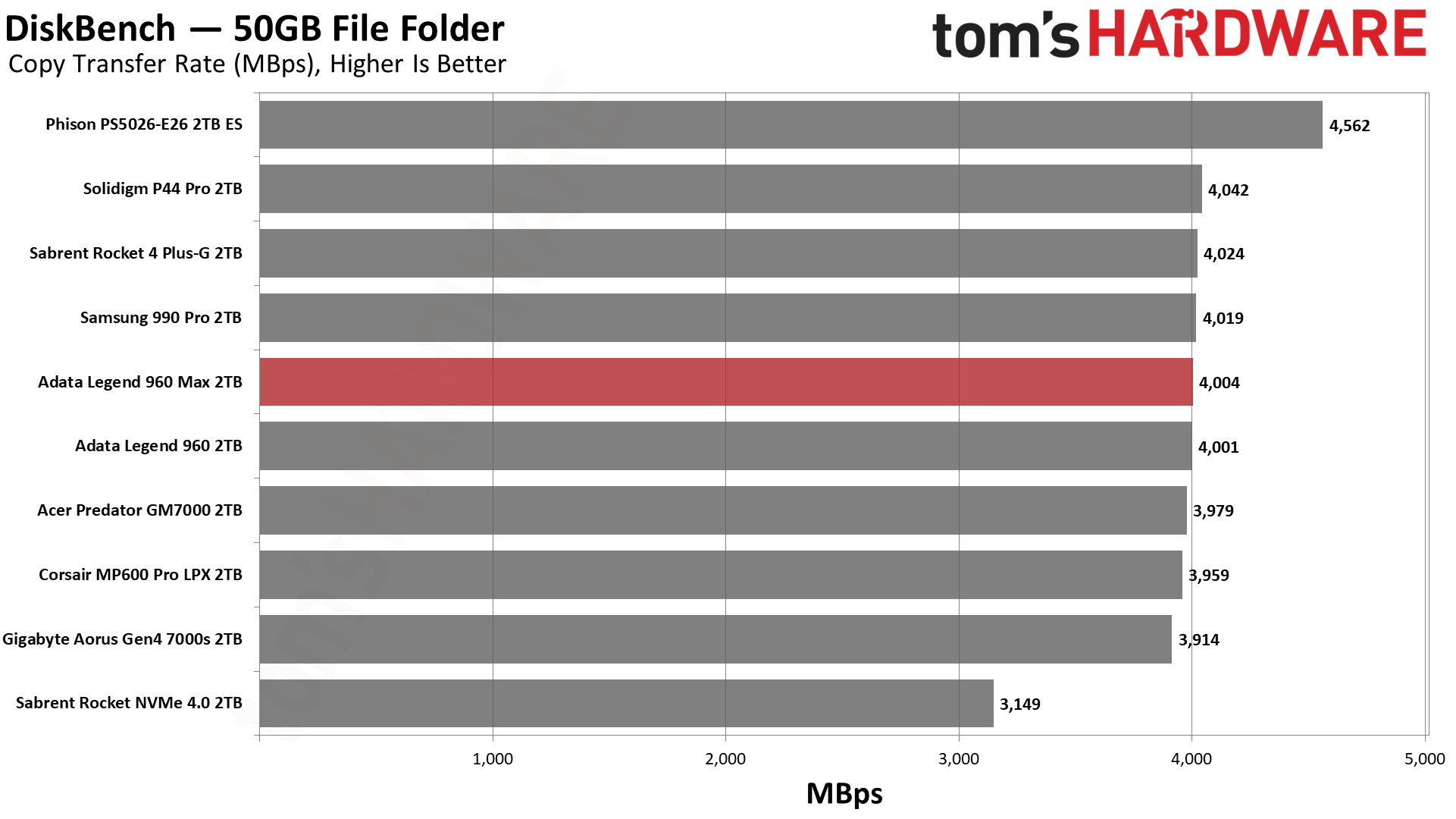
The Legend 960 max copies sufficiently fast, like other high-end PCIe 4.0 SSDs, but does not stand out with reads or writes.
Get Tom's Hardware's best news and in-depth reviews, straight to your inbox.
Synthetic Testing - ATTO / CrystalDiskMark
ATTO and CrystalDiskMark (CDM) are free and easy-to-use storage benchmarking tools that SSD vendors commonly use to assign performance specifications to their products. Both of these tools give us insight into how each device handles different file sizes.
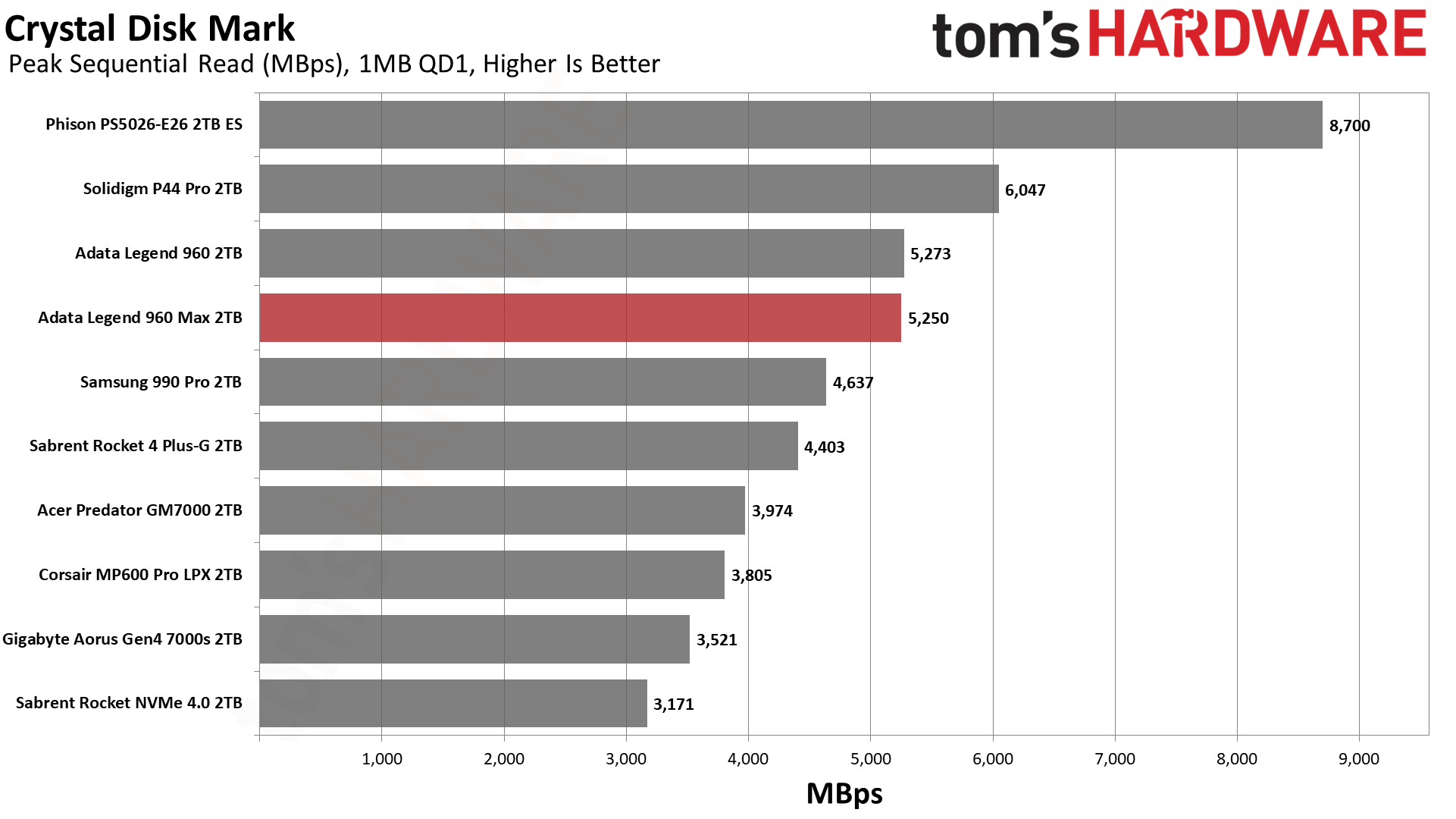
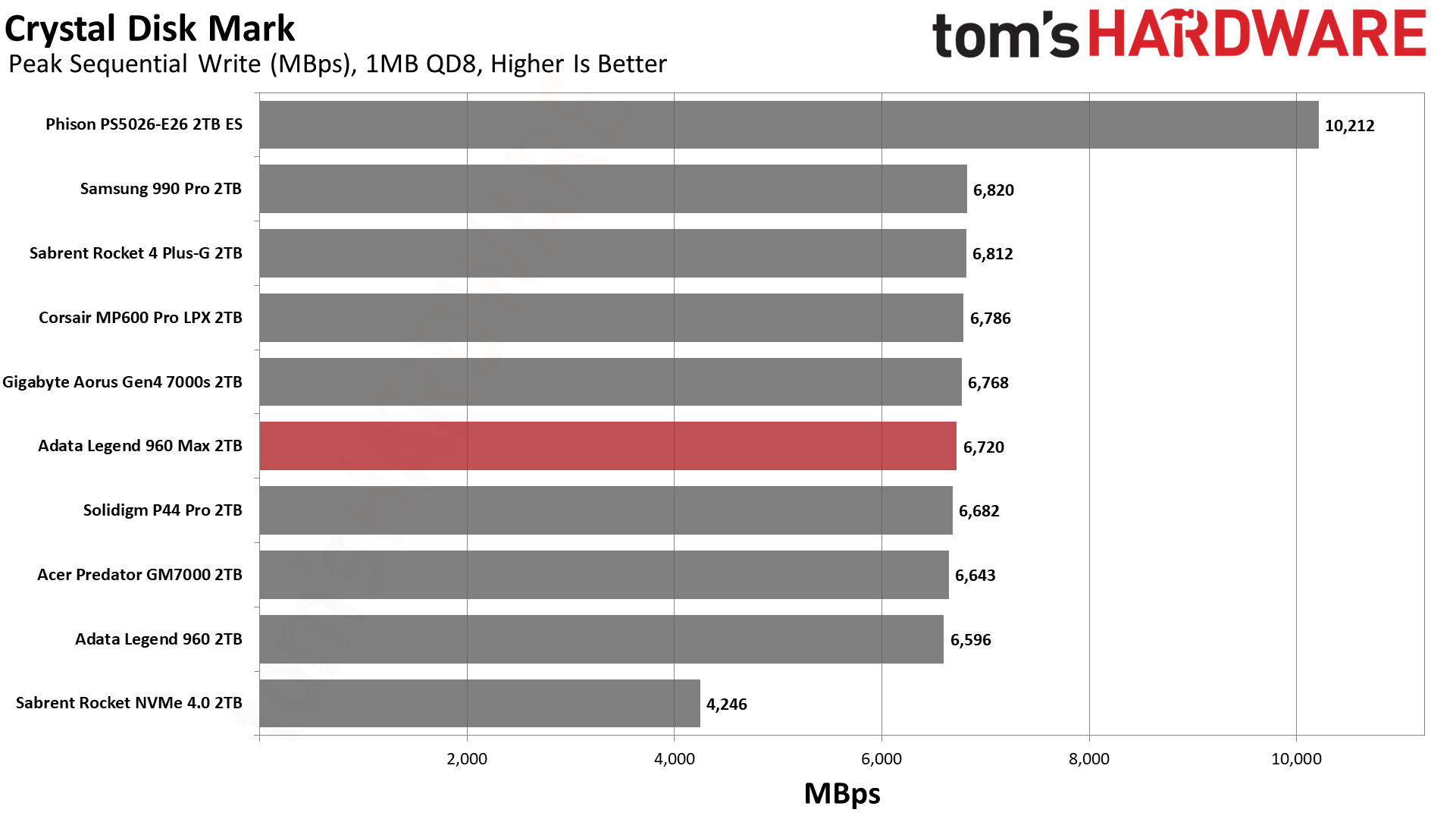
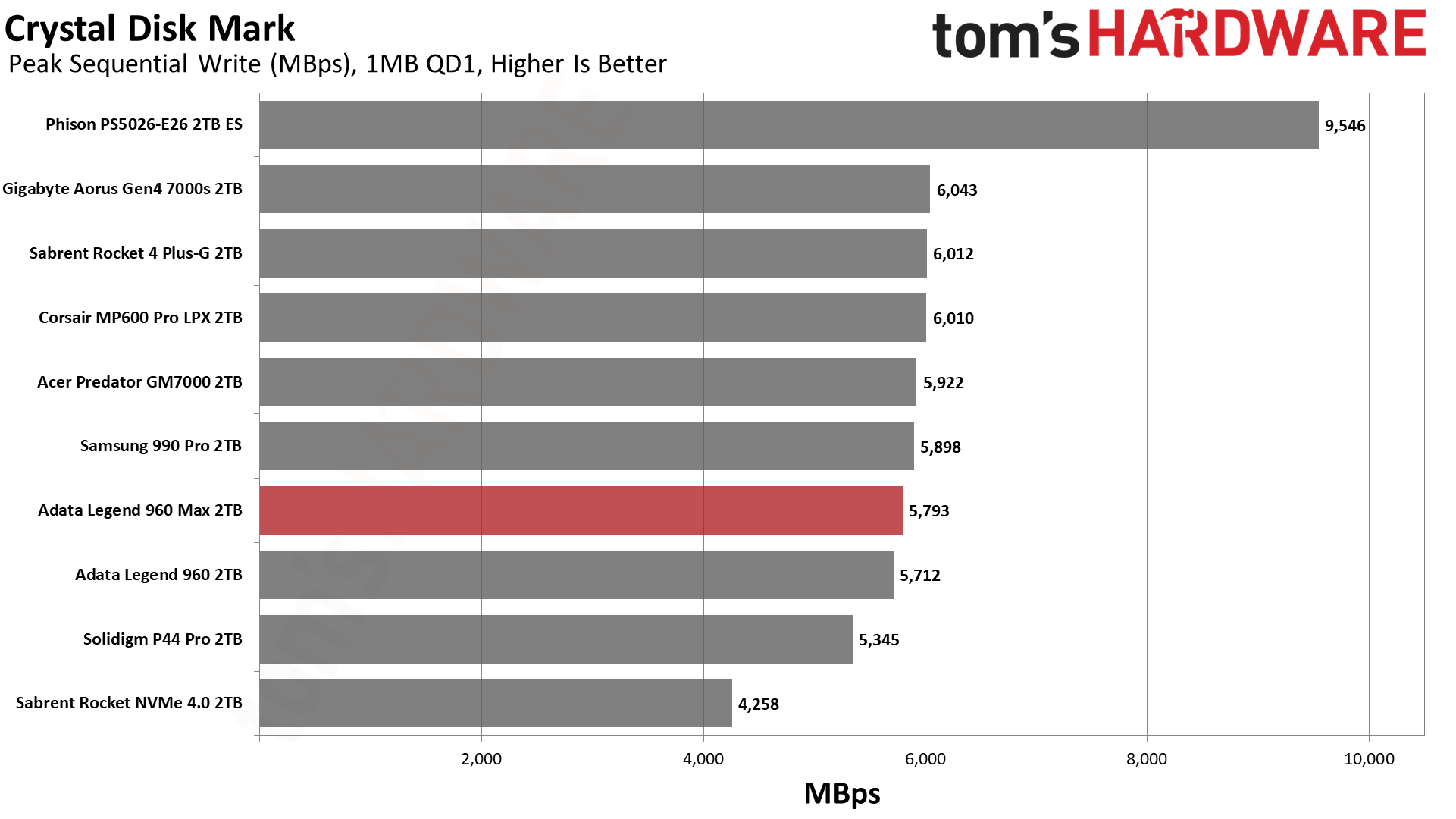
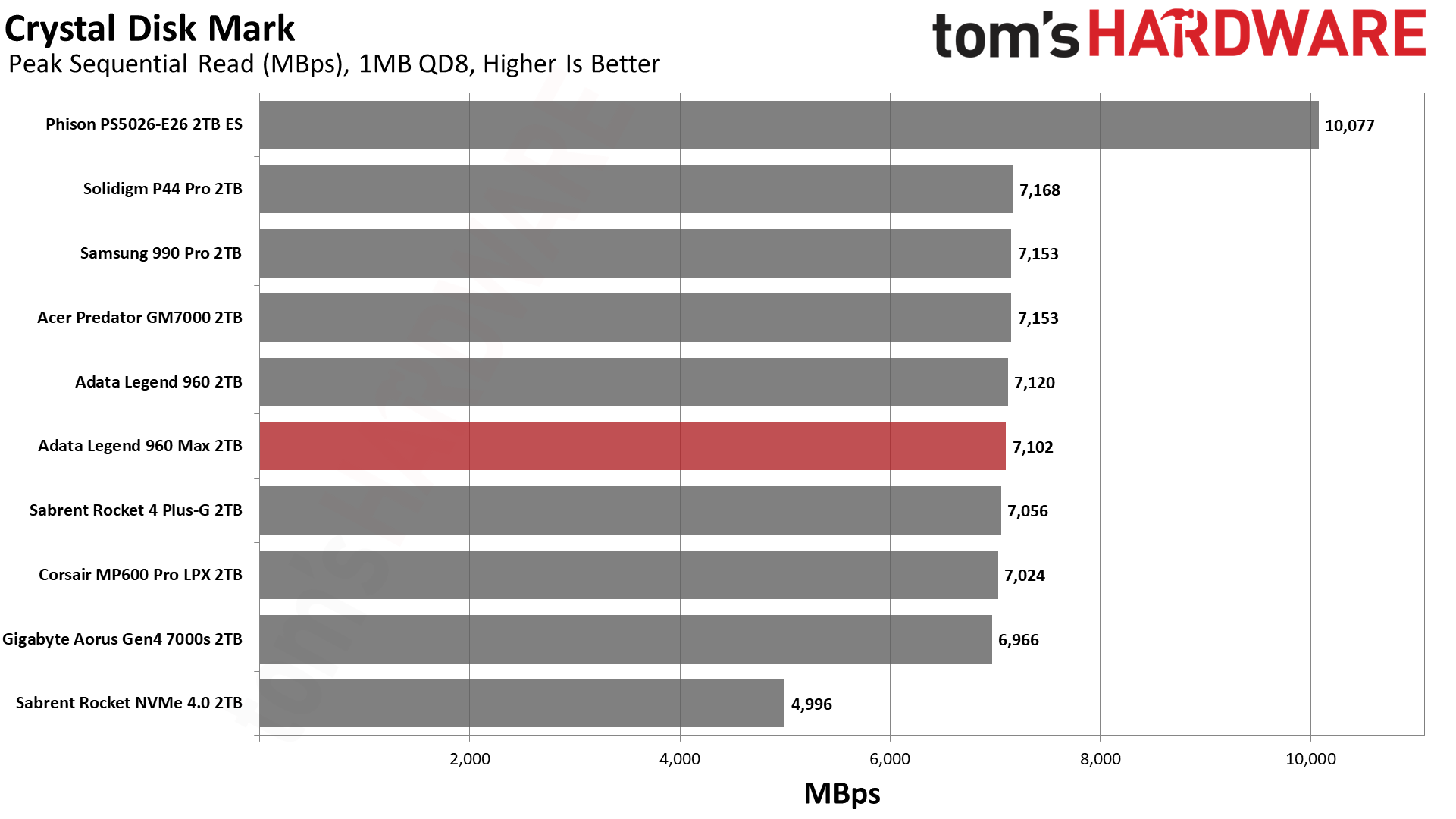
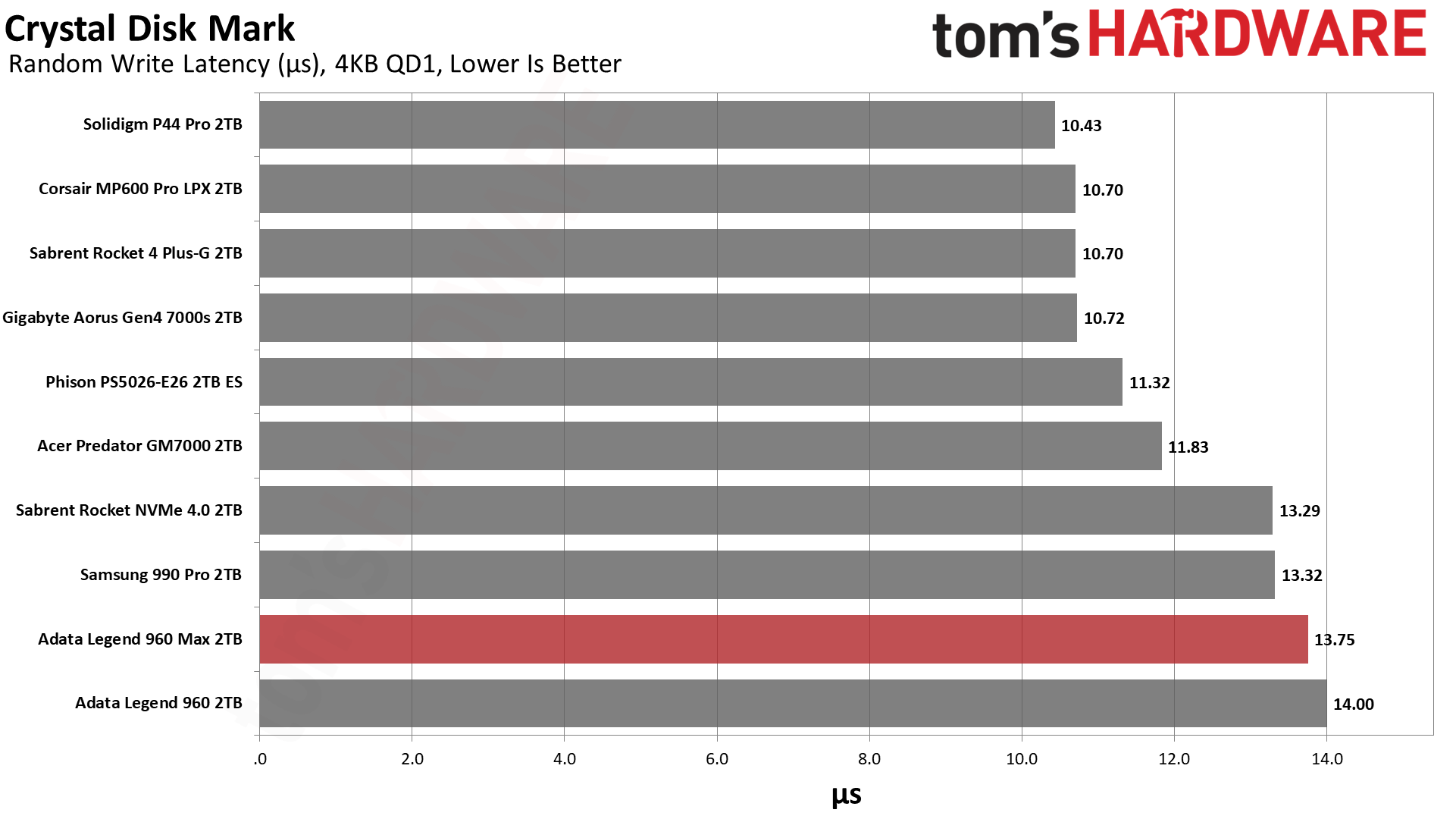

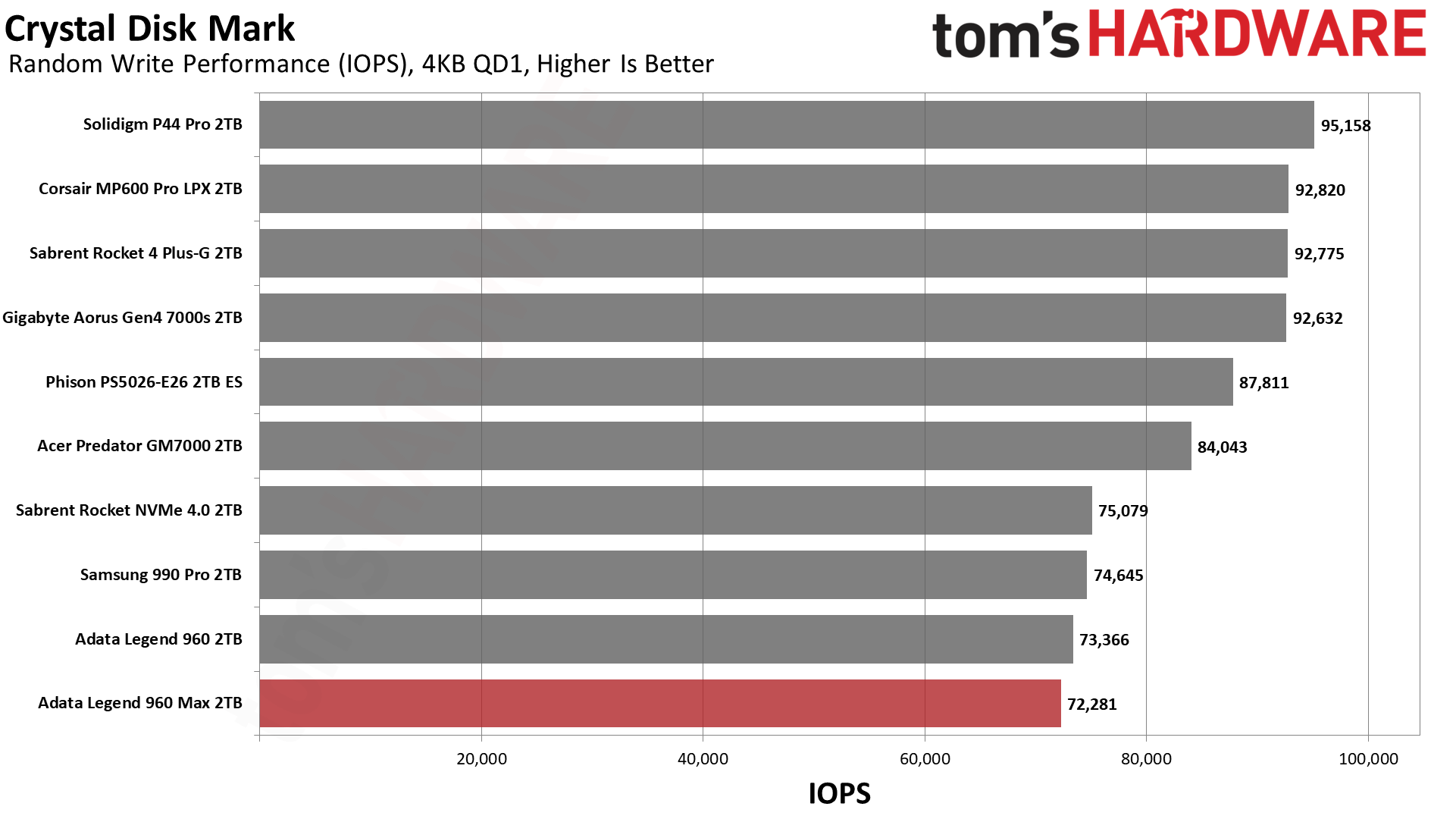
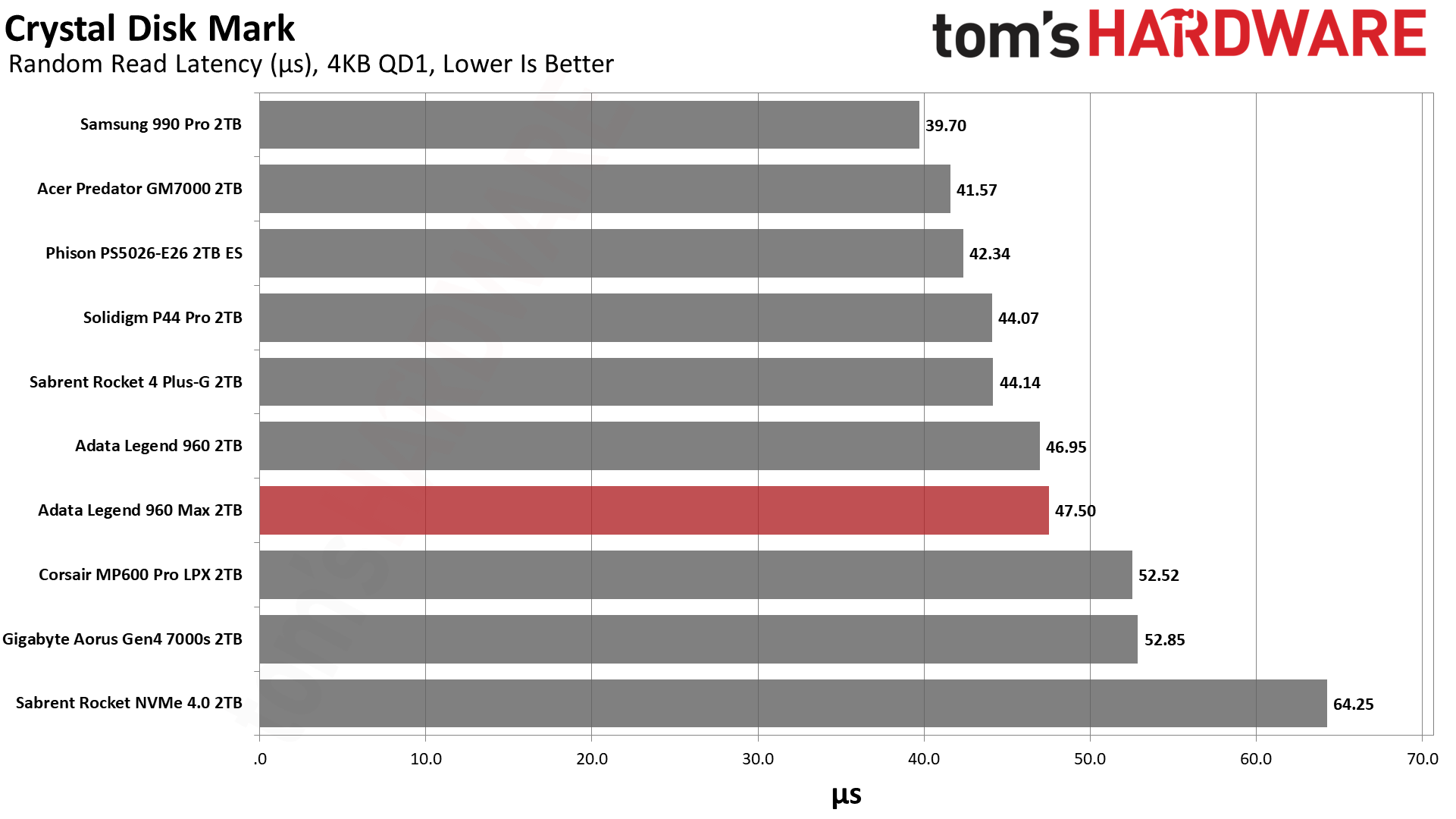
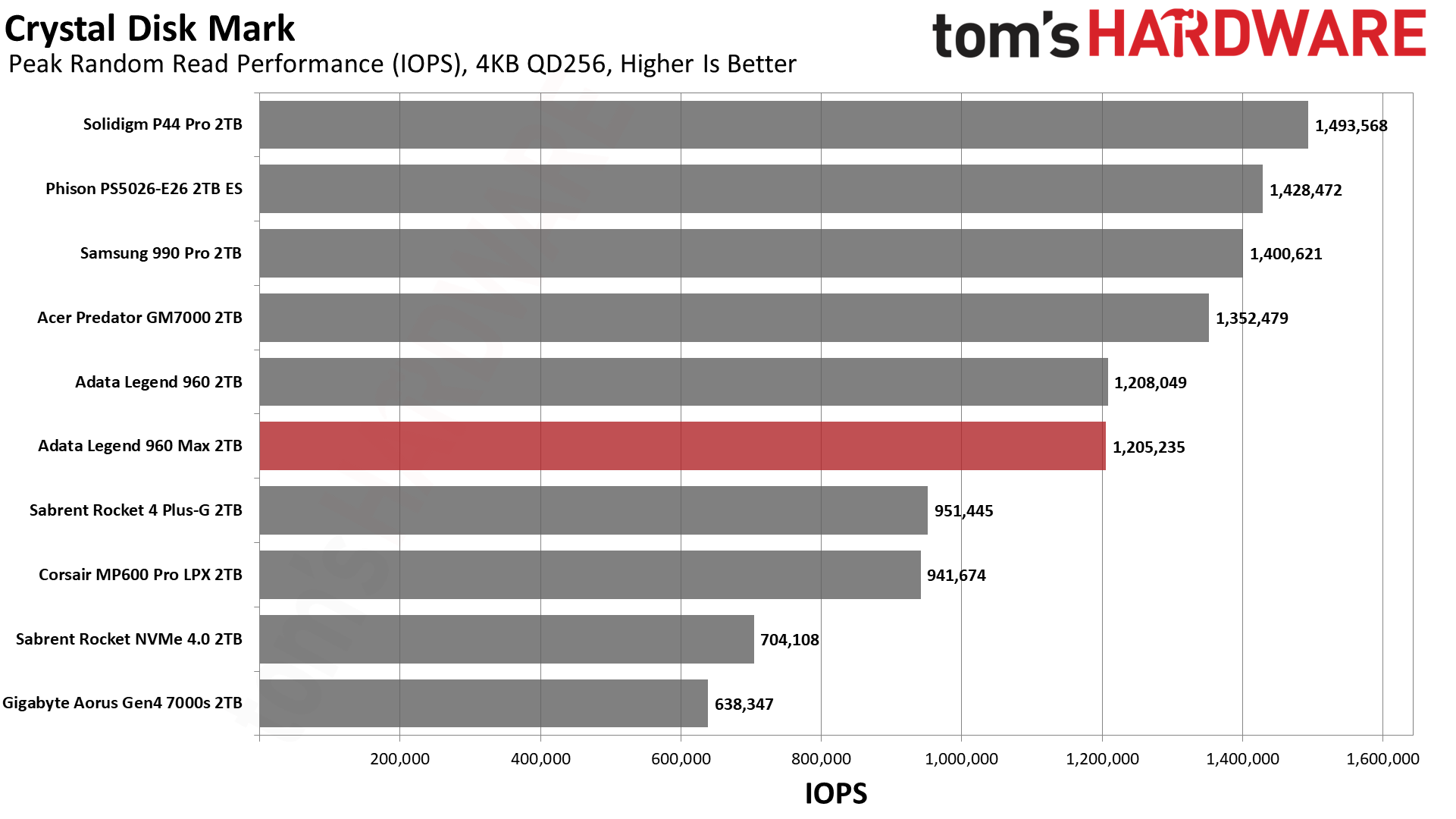
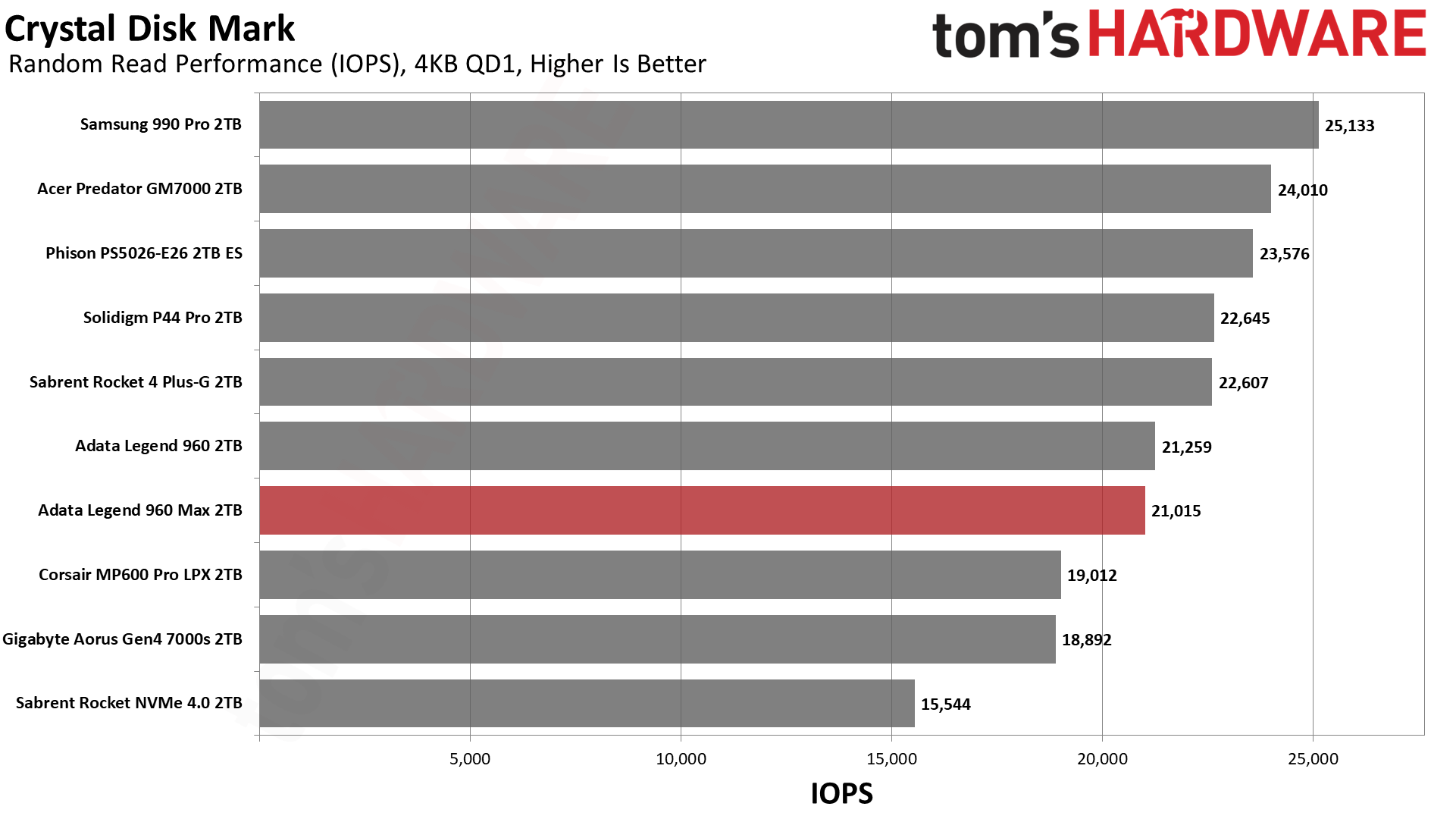
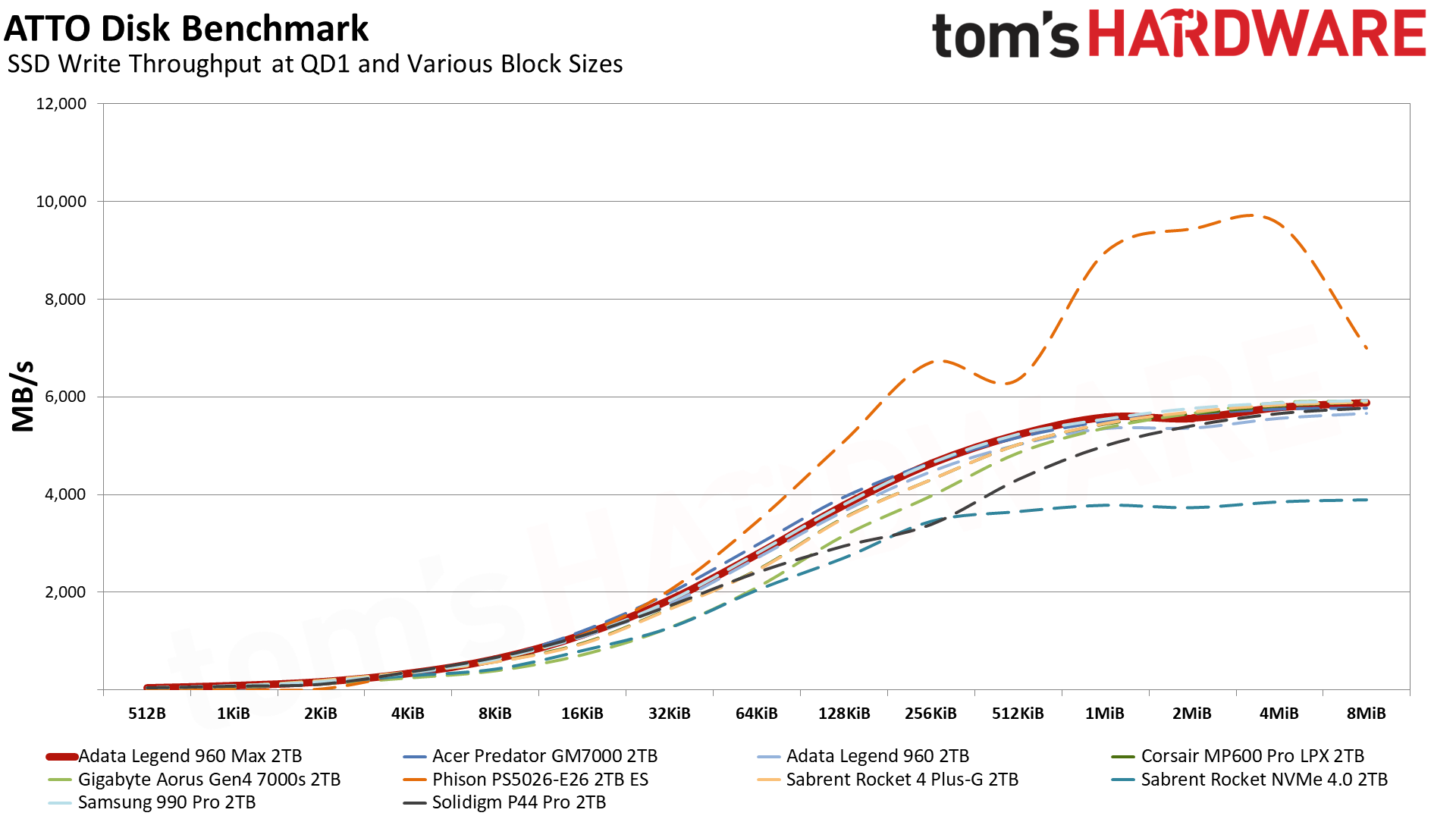
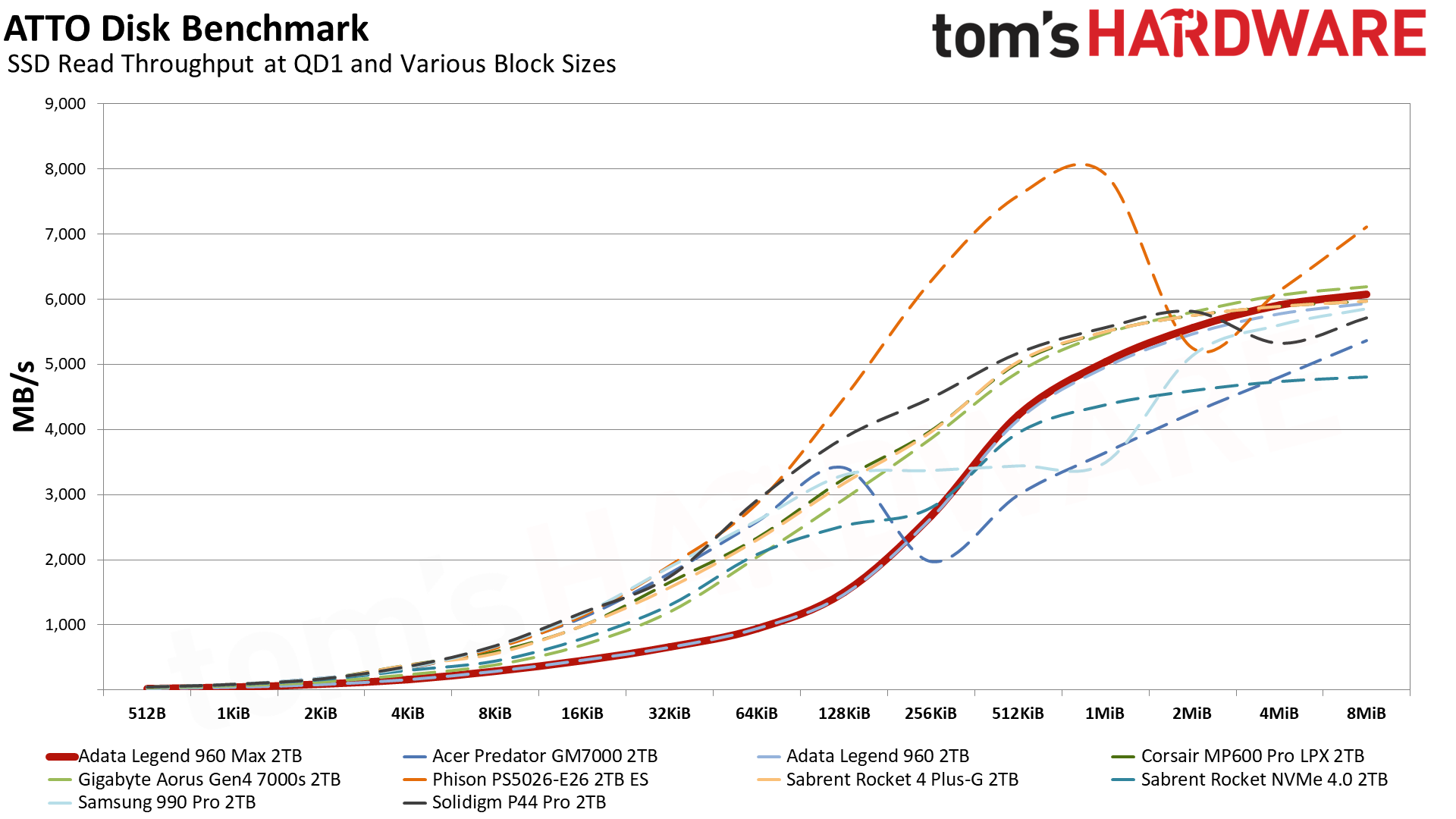
The Legend 960 Max has good ATTO sequential write results, but some improvement would be nice for reads. This could be a factor of the controller with certain block sizes. At 1MB for CDM, things look fine. Random 4KB latency is a bit disappointing as this was an area SMI controllers used to shine. InnoGrit and Phison alternatives simply get more out of this flash.
Sustained Write Performance and Cache Recovery
Official write specifications are only part of the performance picture. Most SSDs implement a write cache, which is a fast area of (usually) pseudo-SLC programmed flash that absorbs incoming data. Sustained write speeds can suffer tremendously once the workload spills outside of the cache and into the "native" TLC or QLC flash.
We use Iometer to hammer the SSD with sequential writes for 15 minutes to measure both the size of the write cache and performance after the cache is saturated. We also monitor cache recovery via multiple idle rounds.
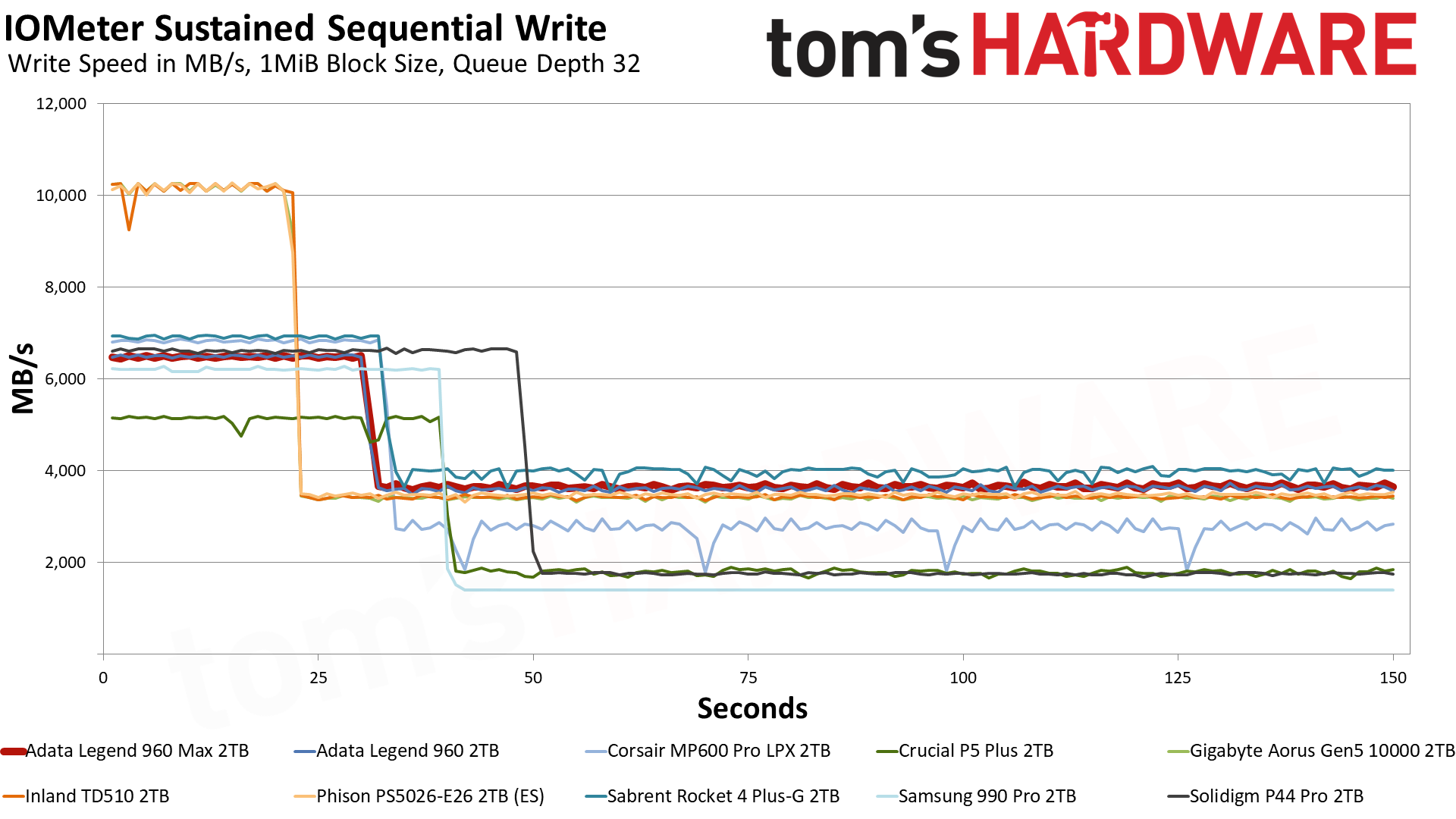
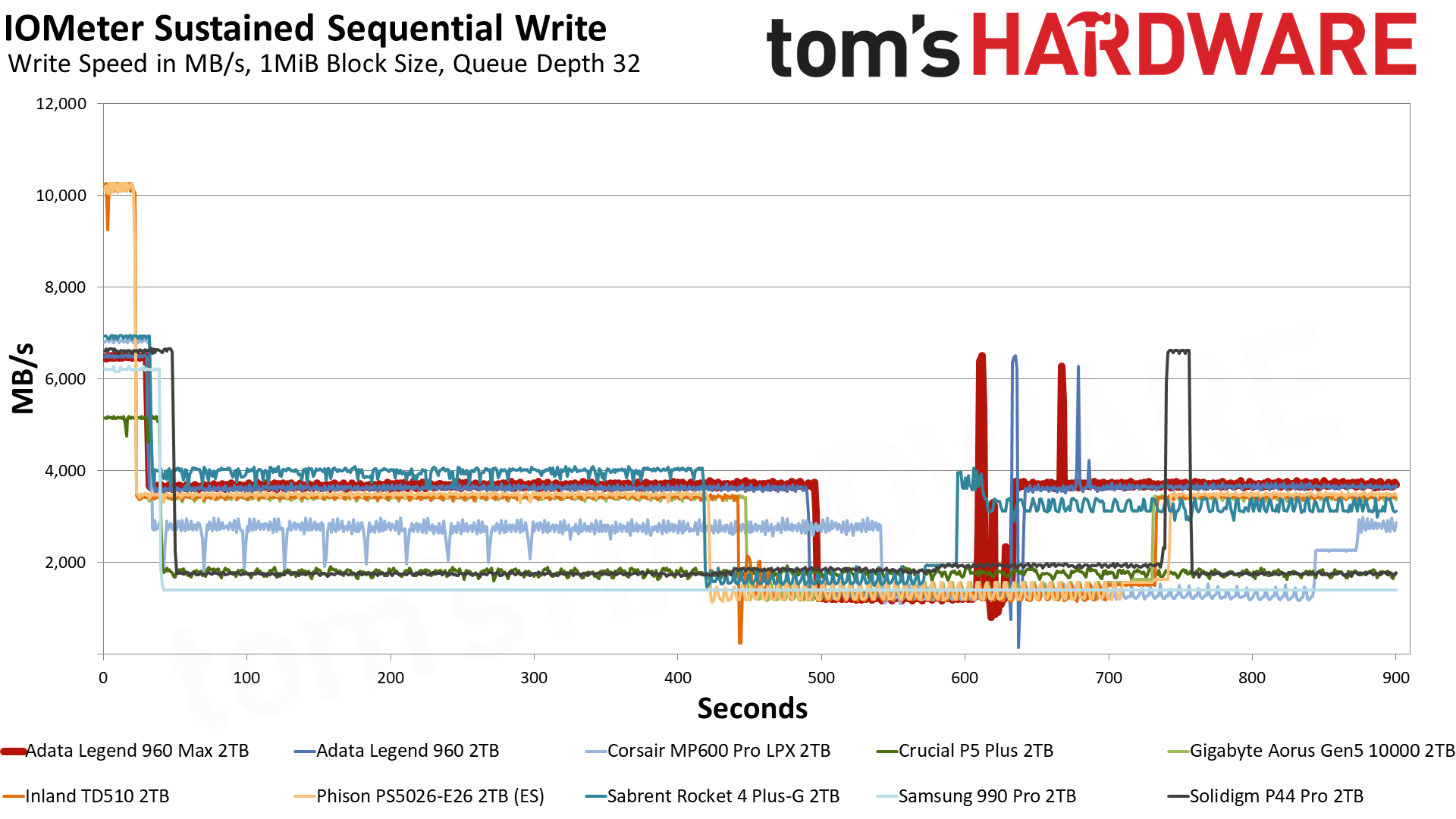
The 2TB Legend 960 Max manages almost 6.5 GBps for over 30 seconds which a sufficiently large cache of 200GB. The TLC mode is pleasing at up to 3.6 GBps, and even folding is reasonable at nearly 1.3 GBps. Recovery to TLC is relatively rapid and its performance is sufficient for some sustained workloads.
As with the original Legend 960, this makes the drive useful for certain workloads while having a cache that’s large enough to handle bursty, random writes. The addition of a heatsink on the Max makes this drive even better as it could work well as a caching drive without suffering from the detrimental aspects of heat.
Power Consumption
We use the Quarch HD Programmable Power Module to gain a deeper understanding of power characteristics. Idle power consumption is an important aspect to consider, especially if you're looking for a laptop upgrade as even the best ultrabooks can have mediocre storage.
Some SSDs can consume watts of power at idle while better-suited ones sip just milliwatts. Average workload power consumption and max consumption are two other aspects of power consumption, but performance-per-watt is more important. A drive might consume more power during any given workload, but accomplishing a task faster allows the drive to drop into an idle state more quickly, ultimately saving energy.
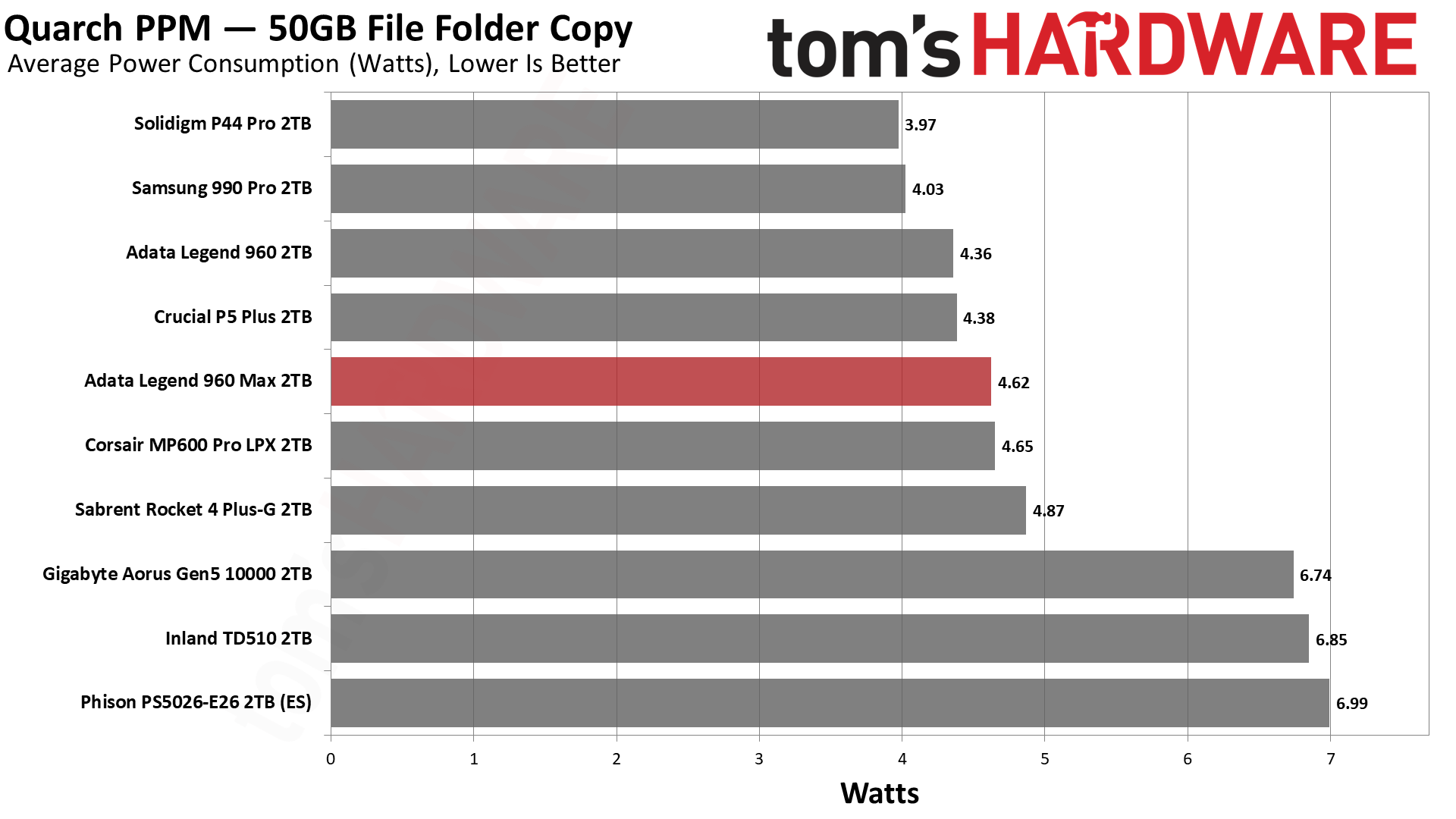
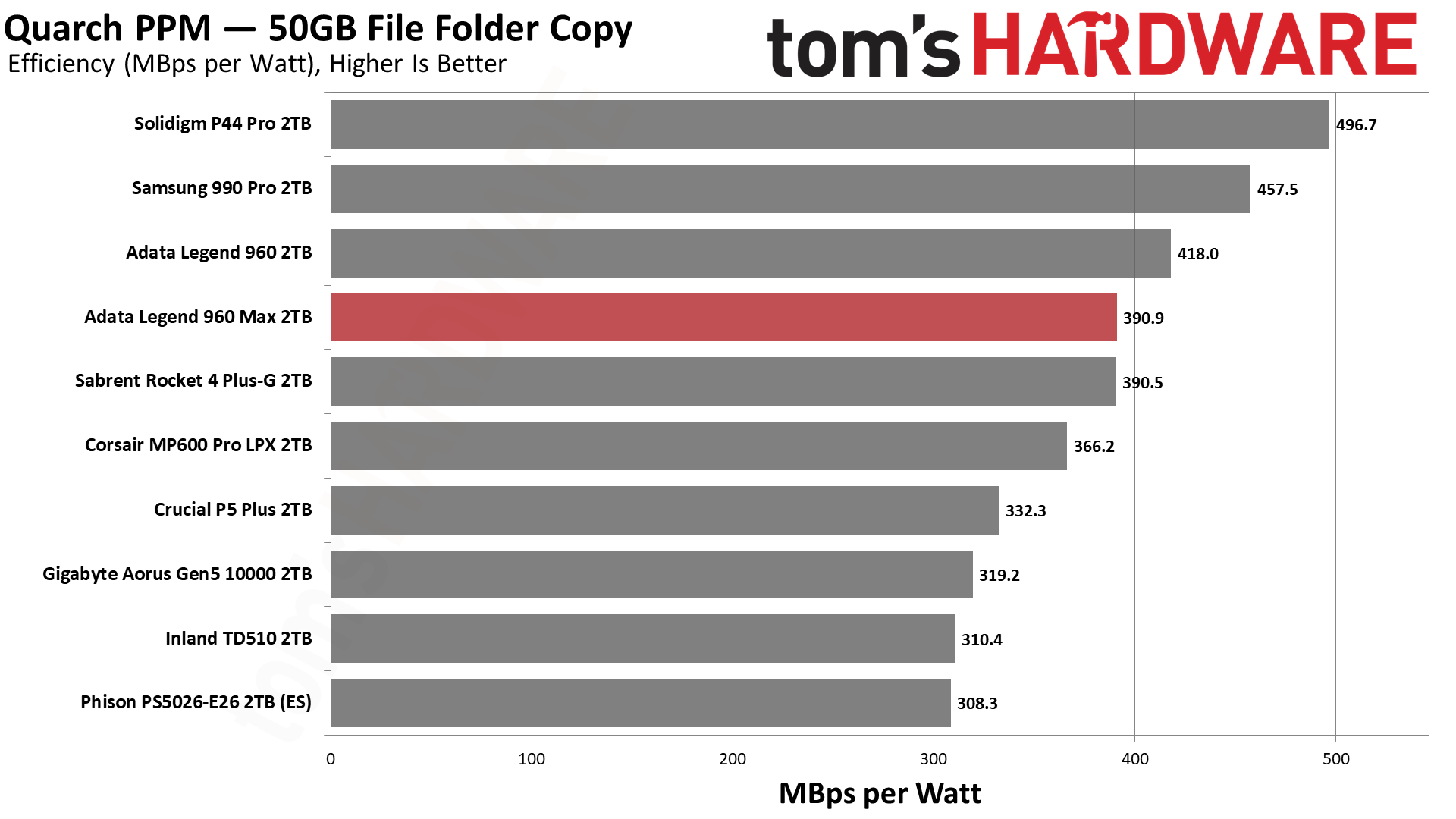
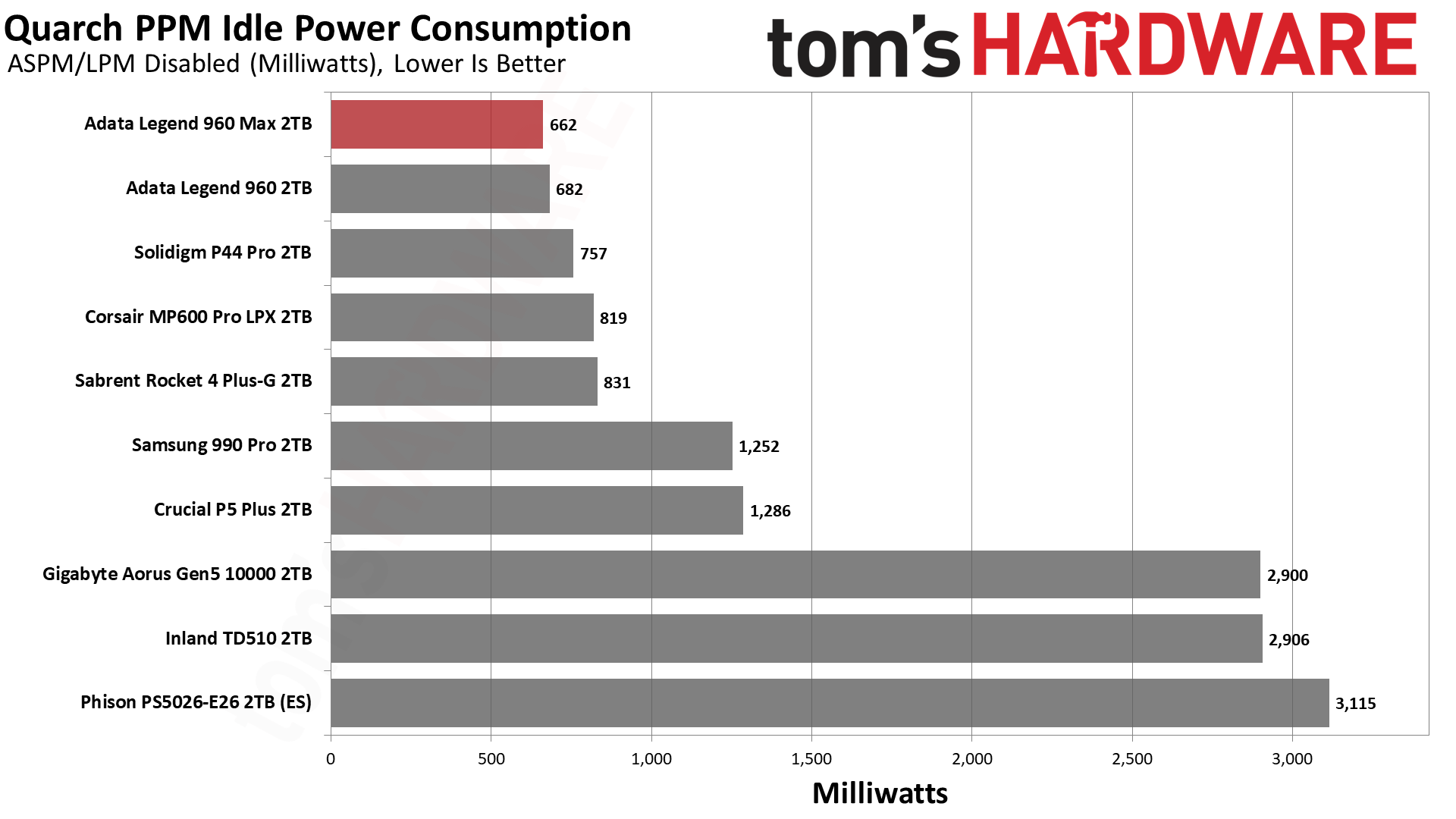
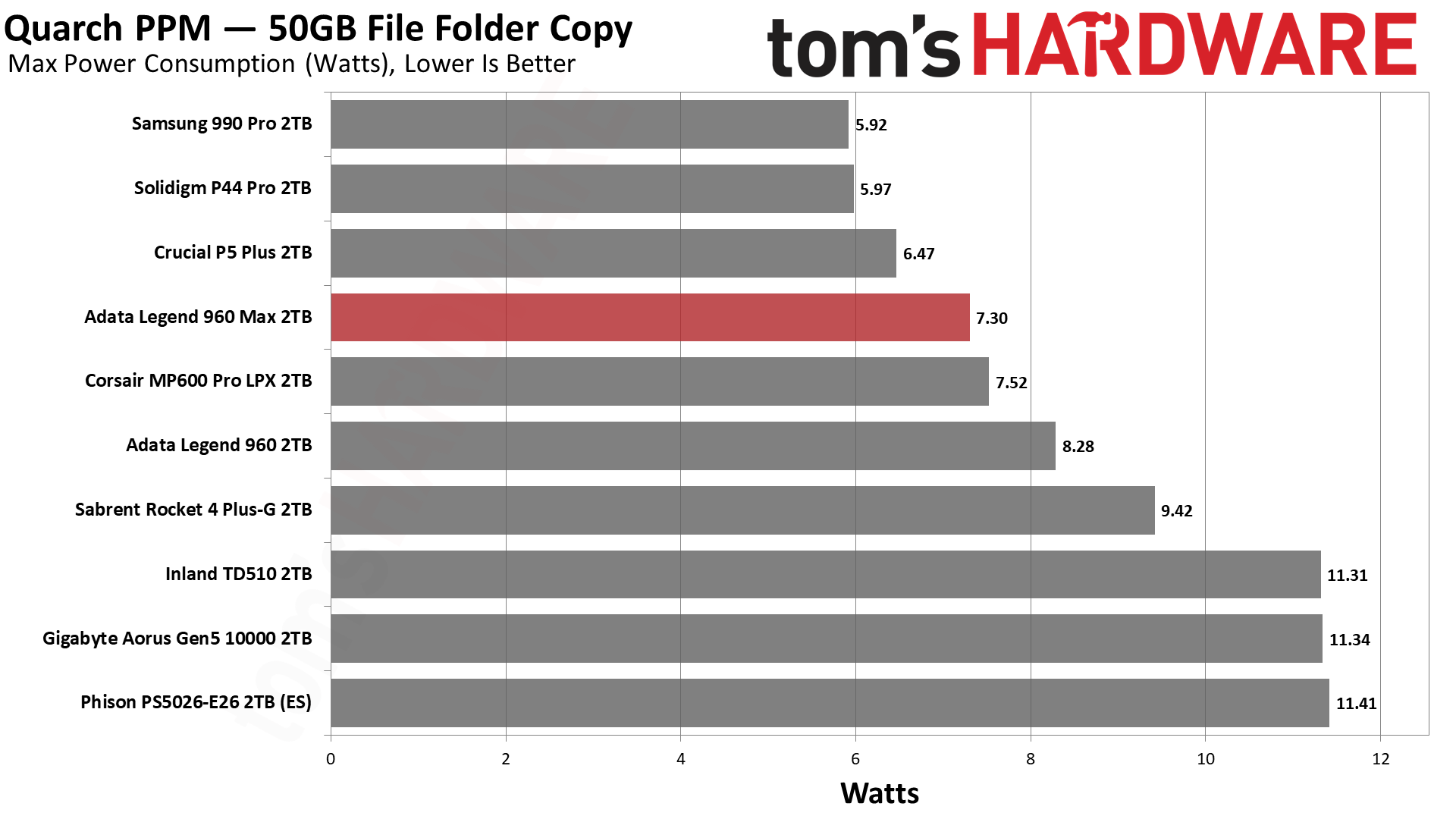
Combined with the above results for write saturation, the Legend 960 Max would be even better if it had good power efficiency under load. Unfortunately, it is not exceptional here, although certainly good enough even for that sort of workload.
The original Legend 960 did not throttle even after 1TB of writes, so the situation just gets better with the Max. In warmer environments and under heavier workloads, the Max is able to maintain consistent performance. This could include in a PS5, since that can get surprisingly warm, or other devices with limited airflow.
Test Bench and Testing Notes
| CPU | Intel Core i9-12900K |
| Motherboard | Asus ROG Maximus Z790 Hero |
| Memory | 2x16GB G.Skill DDR5-5600 CL28 |
| Graphics | Intel Iris Xe UHD Graphics 770 |
| CPU Cooling | Enermax Aquafusion 240 |
| Case | Cooler Master TD500 Mesh V2 |
| Power Supply | Cooler Master V850 i Gold |
| OS Storage | Sabrent Rocket 4 Plus-G 2TB |
| Operating System | Windows 11 Pro |
We use an Alder Lake platform with most background applications such as indexing, Windows updates, and anti-virus disabled in the OS to reduce run-to-run variability. Each SSD is prefilled to 50% capacity and tested as a secondary device. Unless noted, we use active cooling for all SSDs.
Bottom Line
The Adata Legend 960 Max is an ordinary PCIe 4.0 SSD that can offer relatively high levels of performance but does not impress against other options that have been on the market longer. If priced right, it’s a fine alternative for a PS5 or desktop SSD, but otherwise it struggles to stand out in a crowded market. It does have good sustained performance, but this only matches what other controllers with the same flash can do if also designed around a small pSLC cache.
The drive is essentially the regular Legend 960 with a heatsink instead of a headspreader. That’s a good thing as even though the original 960 ran relatively cool, a heatsink makes this very cool-running. Coupled with its potential for sustained writes, this drive could be useful for certain workloads or applications, but again it would have to be cheaper than drives with rival controllers and similar performance characteristics. It’s a nice option to have on the market, but this drive does little to stand out.
MORE: Best SSDs
MORE: Best External SSDs and Hard Drives
MORE: How We Test HDDs And SSDs
MORE: All SSD Content

Shane Downing is a Freelance Reviewer for Tom’s Hardware US, covering consumer storage hardware.
-
Amdlova Reply
It's only a week prior review... swap even pcb and the heatsink aluminum... got one blade s70 comes with out heatsink for inspection... (good ssd survived the torture test...mac_angel said:how long before they start swapping out the parts in this model, too? -
JarredWaltonGPU Reply
I would like to think Adata learned its lesson since the last time. Then again, I've seen multiple other SSDs from other vendors with language that basically says, "We can swap out parts at any time and you should never take the launch specs to be indicative of final hardware." And if you're doing a budget part, that's probably okay — not great, but okay. The problem is when you do that to a drive that gets a good review, and then noticeably downgrade the hardware. Making it better is fine, but changing the model name slightly is also perfectly acceptable.mac_angel said:how long before they start swapping out the parts in this model, too? -
Opcod Well, some do only read about peak transfer.. But in reality, i don't care if i copy a file at 8gbps then after x sec it drop to 1.2g ! The Adata 960 is quite the best performer and only one to give the highest transfert speed sustain. This make a very good one for db, nas, raid sys... And put over a gen3 board, you get higher value.. 'those others' below the max speed. yes gen 3 max at 3.7, but all rest are giving a very efficient boost.Reply -
mac_angel Reply
yea, I don't think it should be legal to do that. Especially after the product has been released to the public and has reviews. If it has different parts in it than the one that was released, then it should be renamed. Even people that know about this practice and somewhat know what to look for have a really hard time in trying to figure out which is which. Even worse when they have a built in heatsink.JarredWaltonGPU said:I would like to think Adata learned its lesson since the last time. Then again, I've seen multiple other SSDs from other vendors with language that basically says, "We can swap out parts at any time and you should never take the launch specs to be indicative of final hardware." And if you're doing a budget part, that's probably okay — not great, but okay. The problem is when you do that to a drive that gets a good review, and then noticeably downgrade the hardware. Making it better is fine, but changing the model name slightly is also perfectly acceptable.
